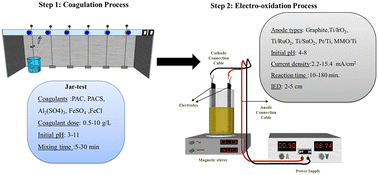Efficient treatment of landfill leachate membrane bioreactor effluent through sequential coagulation–flocculation and electrooxidation
Abstract
This study investigated the performance of sequential chemical coagulation–electrooxidation (EO) processes in treating leachate membrane bioreactor (MBR) effluent. Polyaluminum chloride sulfate (PACS) was selected as the most effective coagulant for the chemical coagulation process, especially for removing suspended solids and color, and the operating parameters were optimized. Under optimum conditions, 79.3% chemical oxygen demand (COD), 81.2% total suspended solids (TSS), 86.1% ultraviolet absorbance at 254 nm (UV254), which represents the relative concentration of aromatic compounds, and 91.3% color removal efficiencies were obtained. The EO process was applied to the coagulation effluent to ensure the discharge limits, where graphite was chosen as the most efficient anode material in terms of both process performance and operating cost. The operating parameters of EO were optimized and under optimum conditions (pH: 7.14, 11 mA cm−2, and inter-electrode distance: 3 cm) in a reaction time of 150 min, 95.4% COD, 50.8% TSS, 81.2% UV254, and 83.6% color removal efficiencies were achieved. The sequential PACS + EO system provided the total removal efficiencies as 98.9% COD, 96.9% TSS, 97.1% UV254, and 99.4% color. The inlet COD was 4950 mg L−1 and the effluent COD of the sequential coagulation–EO process was 47.2 mg L−1. Sequential coagulation–EO process effluent provides receiving environment discharge limits.

- This article is part of the themed collection: Environmental Science: Water Research & Technology Recent HOT Articles


 Please wait while we load your content...
Please wait while we load your content...